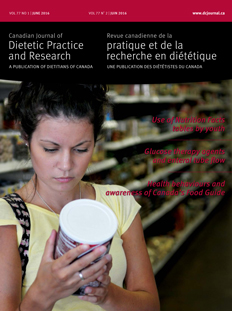Abstract
Purpose: Lifestyle behaviours among adults reporting awareness of Canada’s Food Guide (CFG) are described.
Methods: Data from a cross-sectional survey of adults from Alberta were used to estimate the prevalence of reported health behaviours among respondents aware of the CFG.
Results: Respondents (n = 1044) reported general awareness of CFG (mean age 50.3 years; 54.2% female) of whom 82.2% reported awareness of specific CFG recommendations. Respondents reported frequently reading food labels (>58.0%), reading the number of calories (45.5%), the amount of sodium (49.5%), the amount of fat (46.7%), and the type of fat (45.5%) on the food label. Most respondents (90.0%) reported frequently selecting foods to promote health. Approximately one-third of the respondents (35.8%) reported frequently consuming ≥5 portions of vegetables and fruit per day and regularly participating in physical activity (55.3%). Body weight was perceived as healthy by 63.4% of the respondents. Most engaged in 2 health behaviours frequently. Adjusting for important socio-demographic characteristics, those who reported frequently consuming ≥5 portions of vegetables and fruit per day were more likely to engage in a second health behaviour outlined in CGF (OR: 23.6, 95% CI (16.2–34.4)).
Conclusion: Awareness of CFG did not translate to positive health behaviours. More proactive population level strategies to support specific health behaviours as outlined in CFG might be warranted.
Résumé
Objectif. Décrire les comportements propres au style de vie des adultes qui affirment connaître le Guide alimentaire canadien (GAC).
Méthodes. Des données tirées d’une enquête transversale portant sur des adultes de l’Alberta ont été utilisées pour estimer la prévalence des comportements relatifs à la santé déclarés chez des répondants connaissant le GAC.
Résultats. Les répondants (n = 1044; âge moyen de 50,3 ans; 54,2 % de femmes) ont indiqué posséder une connaissance générale du GAC, et 82,2 % ont déclaré connaître des recommandations précises du GAC. Les répondants ont indiqué lire fréquemment les étiquettes nutritionnelles (>58,0 %), le nombre de calories (45,5 %), la quantité de sodium (49,5 %), la quantité de matières grasses (46,7 %) et le type de matières grasses (45,5 %) sur les étiquettes nutritionnelles. La majeure partie des répondants (90,0 %) ont indiqué choisir fréquemment des aliments qui favorisent la santé. Environ un tiers des répondants (35,8 %) ont indiqué consommer fréquemment ≥ 5 portions de légumes et fruits par jour et faire régulièrement de l’activité physique (55,3 %). Parmi les répondants, 63,4 % ont indiqué avoir un poids corporel qu’ils jugeaient santé. La majorité des répondants adoptaient fréquemment deux comportements sains. À la suite d’un ajustement selon les caractéristiques sociodémographiques importantes, les répondants qui indiquaient consommer fréquemment ≥ 5 portions de légumes et fruits par jour étaient plus susceptibles d’adopter un deuxième comportement sain décrit dans le GAC (OU : 23,6, IC à 95 % [16,2–34,4]).
Conclusion. La connaissance du GAC ne se traduisait pas par des comportements relatifs à la santé positifs. Il pourrait être justifié de mettre en place plus de stratégies proactives auprès de la population afin d’encourager l’adoption de comportements relatifs à la santé particuliers décrits dans le GAC.



